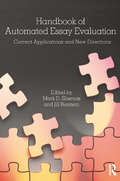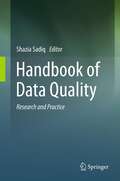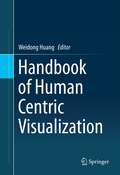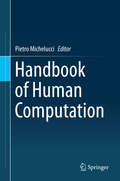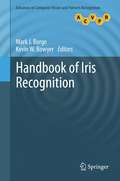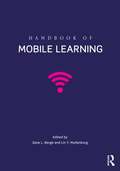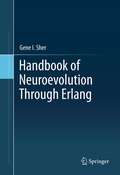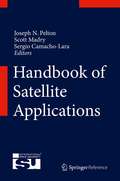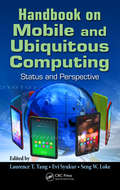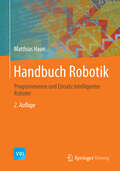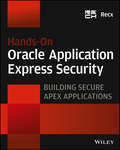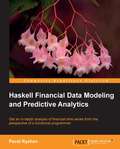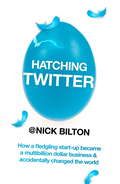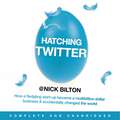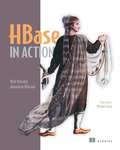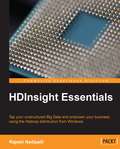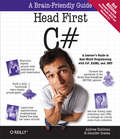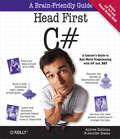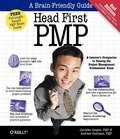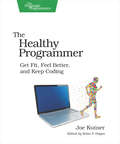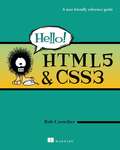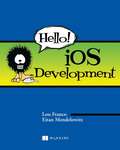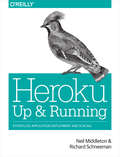- Table View
- List View
Handbook of Automated Essay Evaluation: Current Applications and New Directions
by Mark D. Shermis Jill BursteinThis comprehensive, interdisciplinary handbook reviews the latest methods and technologies used in automated essay evaluation (AEE) methods and technologies. Highlights include the latest in the evaluation of performance-based writing assessments and recent advances in the teaching of writing, language testing, cognitive psychology, and computational linguistics. This greatly expanded follow-up to Automated Essay Scoring reflects the numerous advances that have taken place in the field since 2003 including automated essay scoring and diagnostic feedback. Each chapter features a common structure including an introduction and a conclusion. Ideas for diagnostic and evaluative feedback are sprinkled throughout the book. Highlights of the book’s coverage include: The latest research on automated essay evaluation. Descriptions of the major scoring engines including the E-rater®, the Intelligent Essay Assessor, the Intellimetric™ Engine, c-rater™, and LightSIDE. Applications of the uses of the technology including a large scale system used in West Virginia. A systematic framework for evaluating research and technological results. Descriptions of AEE methods that can be replicated for languages other than English as seen in the example from China. Chapters from key researchers in the field. The book opens with an introduction to AEEs and a review of the "best practices" of teaching writing along with tips on the use of automated analysis in the classroom. Next the book highlights the capabilities and applications of several scoring engines including the E-rater®, the Intelligent Essay Assessor, the Intellimetric™ engine, c-rater™, and LightSIDE. Here readers will find an actual application of the use of an AEE in West Virginia, psychometric issues related to AEEs such as validity, reliability, and scaling, and the use of automated scoring to detect reader drift, grammatical errors, discourse coherence quality, and the impact of human rating on AEEs. A review of the cognitive foundations underlying methods used in AEE is also provided. The book concludes with a comparison of the various AEE systems and speculation about the future of the field in light of current educational policy. Ideal for educators, professionals, curriculum specialists, and administrators responsible for developing writing programs or distance learning curricula, those who teach using AEE technologies, policy makers, and researchers in education, writing, psychometrics, cognitive psychology, and computational linguistics, this book also serves as a reference for graduate courses on automated essay evaluation taught in education, computer science, language, linguistics, and cognitive psychology.
Handbook of Data Quality: Research and Practice
by Shazia SadiqThe issue of data quality is as old as data itself. However, the proliferation of diverse, large-scale and often publically available data on the Web has increased the risk of poor data quality and misleading data interpretations. On the other hand, data is now exposed at a much more strategic level e.g. through business intelligence systems, increasing manifold the stakes involved for individuals, corporations as well as government agencies. There, the lack of knowledge about data accuracy, currency or completeness can have erroneous and even catastrophic results. With these changes, traditional approaches to data management in general, and data quality control specifically, are challenged. There is an evident need to incorporate data quality considerations into the whole data cycle, encompassing managerial/governance as well as technical aspects. Data quality experts from research and industry agree that a unified framework for data quality management should bring together organizational, architectural and computational approaches. Accordingly, Sadiq structured this handbook in four parts: Part I is on organizational solutions, i.e. the development of data quality objectives for the organization, and the development of strategies to establish roles, processes, policies, and standards required to manage and ensure data quality. Part II, on architectural solutions, covers the technology landscape required to deploy developed data quality management processes, standards and policies. Part III, on computational solutions, presents effective and efficient tools and techniques related to record linkage, lineage and provenance, data uncertainty, and advanced integrity constraints. Finally, Part IV is devoted to case studies of successful data quality initiatives that highlight the various aspects of data quality in action. The individual chapters present both an overview of the respective topic in terms of historical research and/or practice and state of the art, as well as specific techniques, methodologies and frameworks developed by the individual contributors. Researchers and students of computer science, information systems, or business management as well as data professionals and practitioners will benefit most from this handbook by not only focusing on the various sections relevant to their research area or particular practical work, but by also studying chapters that they may initially consider not to be directly relevant to them, as there they will learn about new perspectives and approaches.
Handbook of Distance Education: Second Edition
by Michael Grahame MooreThe Handbook of Distance Education, 4th Edition is a comprehensive compendium of research in the field of distance education. The volume is divided into four sections covering the historical and theoretical foundations of distance education, attributes of teaching and learning using technology, management and administration, and different audiences and providers. Throughout, leading scholars address future research needs and directions based on current research, established practices, and recent changes to implementation, pedagogy, and policy.
Handbook of Human Centric Visualization
by Weidong HuangVisualizations are visual representations of non-visual data. They are produced for people to interact with and to make sense of the underlying data. Rapid advances in display technology and computer power have enabled researchers to produce visually appealing pictures. However, the effectiveness of those pictures in conveying the embedded information to end users has not been fully explored. Handbook of Human Centric Visualization addresses issues related to design, evaluation and application of visualizations. Topics include visualization theories, design principles, evaluation methods and metrics, human factors, interaction methods and case studies. This cutting-edge book includes contributions from well-established researchers worldwide, from diverse disciplines including psychology, visualization and human-computer interaction. This handbook is designed for a professional audience composed of practitioners, lecturers and researchers working in the field of computer graphics, visualization, human-computer interaction and psychology. Undergraduate and postgraduate students in science and engineering focused on this topic will also find this book useful as a comprehensive textbook or reference.
Handbook of Human Computation
by Pietro MichelucciThis volume addresses the emerging area of human computation, The chapters, written by leading international researchers, explore existing and future opportunities to combine the respective strengths of both humans and machines in order to create powerful problem-solving capabilities. The book bridges scientific communities, capturing and integrating the unique perspective and achievements of each. It coalesces contributions from industry and across related disciplines in order to motivate, define, and anticipate the future of this exciting new frontier in science and cultural evolution. Readers can expect to find valuable contributions covering Foundations; Application Domains; Techniques and Modalities; Infrastructure and Architecture; Algorithms; Participation; Analysis; Policy and Security and the Impact of Human Computation. Researchers and professionals will find the Handbook of Human Computation a valuable reference tool. The breadth of content also provides a thorough foundation for students of the field.
Handbook of Iris Recognition
by Mark J. Burge Kevin BowyerThis authoritative collection introduces the reader to the state of the art in iris recognition technology. Topics and features: with a Foreword by the "father of iris recognition," Professor John Daugman of Cambridge University; presents work from an international selection of preeminent researchers, reflecting the uses of iris recognition in many different social contexts; provides viewpoints from researchers in government, industry and academia, highlighting how iris recognition is both a thriving industry and an active research area; surveys previous developments in the field, and covers topics ranging from the low-level (e.g., physics of iris image acquisition) to the high level (e.g., alternative non-Daugman approaches to iris matching); introduces many active and open areas of research in iris recognition, including cross-wavelength matching and iris template aging. This book is an essential resource for anyone wishing to improve their understanding of iris recognition technology.
Handbook of Mobile Learning
by Zane L. Berge Lin Y. MuilenburgThis handbook provides a comprehensive compendium of research in all aspects of mobile learning, one of the most significant ongoing global developments in the entire field of education. Rather than focus on specific technologies, expert authors discuss how best to utilize technology in the service of improving teaching and learning.
Handbook of Neuroevolution Through Erlang
by Gene I. SherHandbook of Neuroevolution Through Erlang presents both the theory behind, and the methodology of, developing a neuroevolutionary-based computational intelligence system using Erlang. With a foreword written by Joe Armstrong, this handbook offers an extensive tutorial for creating a state of the art Topology and Weight Evolving Artificial Neural Network (TWEANN) platform. In a step-by-step format, the reader is guided from a single simulated neuron to a complete system. By following these steps, the reader will be able to use novel technology to build a TWEANN system, which can be applied to Artificial Life simulation, and Forex trading. Because of Erlang's architecture, it perfectly matches that of evolutionary and neurocomptational systems. As a programming language, it is a concurrent, message passing paradigm which allows the developers to make full use of the multi-core & multi-cpu systems. Handbook of Neuroevolution Through Erlang explains how to leverage Erlang's features in the field of machine learning, and the system's real world applications, ranging from algorithmic financial trading to artificial life and robotics.
The Handbook of Personal Area Networking Technologies and Protocols
by Dean Anthony GrattonThis handbook offers an unparalleled view of wireless personal area networking technologies and their associated protocols. It lifts the lid on their growing adoption within the consumer electronics, home automation, sports, health and well-being markets. Bluetooth low energy, ZigBee, EnOcean and ANT+ are comprehensively covered, along with other WPAN technologies including NFC, Wi-Fi, Bluetooth classic and high speed, and WHDI. It also features 802. 11ac, the Internet of Things, Wireless USB, WiGig and WirelessHD. The handbook shows how white space radio, cellular and Femtocells have inadvertently blurred the boundaries between personal and wide area communications, creating disruptive topologies through technology convergence. It explores how pervasive WAN technologies have spawned a new generation of consumers through the Lawnmower Man Effect and explains how our personal space has become integral to social media streams, including Twitter, Facebook and Pinterest. An essential read for students, software engineers and developers, product planners, technical marketers and analysts.
Handbook of Satellite Applications
by Sergio Camacho-Lara Scott Madry Joseph N. PeltonTop space experts from around the world have collaborated to produce this comprehensive, authoritative, and clearly illustrated reference guide to the fast growing, multi-billion dollar field of satellite applications and space communications. This handbook, done under the auspices of the International Space University based in France, addresses not only system technologies but also examines market dynamics, technical standards and regulatory constraints. The handbook is a completely multi-disciplinary reference book that covers, in an in-depth fashion, the fields of satellite telecommunications, Earth observation, remote sensing, satellite navigation, geographical information systems, and geosynchronous meteorological systems. It covers current practices and designs as well as advanced concepts and future systems. It provides a comparative analysis of the common technologies and design elements for satellite application bus structures, thermal controls, power systems, stabilization techniques, telemetry, command and control (TTC), and orbital configurations. These common aspects are addressed in an integrated fashion to explain how all these space systems share similar design features, but also have quite specialized application packages to carry out their various missions. No other reference in print today provides such a comprehensive and in-depth guide to all forms of application satellites, including small sats as used by countries just beginning space application programs.
Handbook on Mobile and Ubiquitous Computing: Status and Perspective
by Laurence T. Yang Evi Syukur Seng W. LokeConsolidating recent research in the area, the Handbook on Mobile and Ubiquitous Computing: Status and Perspective illustrates the design, implementation, and deployment of mobile and ubiquitous systems, particularly in mobile and ubiquitous environments, modeling, database components, and wireless infrastructures.Supplying an overarching perspecti
Handbuch Robotik
by Matthias HaunZiele des Buches ist es, den Roboter als lernendes System aufzufassen, es als wissensbasiertes Modellsystem zu konzeptionalisieren und dieses System durch intelligente, rechnerbasierte Technologien in funktionaler Hinsicht zu implementieren. Das Ziel eines Ansatzes liegt in der Steigerung des systemischen Intelligenzquotienten (sIQ). Erreichbar wird dieses Ziel durch eine Modellierung auf Basis der Kognitionstheorie und der konkreten (Aus) implementierung dieser Modelle durch den Einsatz der Cognitive Computing Technologien unter der Programmiersprache Java.
Hands-On Oracle Application Express Security
by RecxAn example-driven approach to securing Oracle APEX applicationsAs a Rapid Application Development framework, Oracle Application Express (APEX) allows websites to easily be created based on data within an Oracle database. Using only a web browser, you can develop and deploy professional applications that are both fast and secure. However, as with any website, there is a security risk and threat, and securing APEX applications requires some specific knowledge of the framework. Written by well-known security specialists Recx, this book shows you the correct ways to implement your APEX applications to ensure that they are not vulnerable to attacks. Real-world examples of a variety of security vulnerabilities demonstrate attacks and show the techniques and best practices for making applications secure. Divides coverage into four sections, three of which cover the main classes of threat faced by web applications and the forth covers an APEX-specific protection mechanismAddresses the security issues that can arise, demonstrating secure application designExamines the most common class of vulnerability that allows attackers to invoke actions on behalf of other users and access sensitive dataThe lead-by-example approach featured in this critical book teaches you basic "hacker" skills in order to show you how to validate and secure your APEX applications.
Haskell Financial Data Modeling and Predictive Analytics
by Pavel RyzhovThis book is a hands-on guide that teaches readers how to use Haskell's tools and libraries to analyze data from real-world sources in an easy-to-understand manner.This book is great for developers who are new to financial data modeling using Haskell. A basic knowledge of functional programming is not required but will be useful. An interest in high frequency finance is essential.
Hatching Twitter: A True Story of Money, Power, Friendship and Betrayal
by Nick Bilton'A tale of Machiavellian plots and coups d'etat, it's just all so gripping' Chris Evans, BBC Radio 2THE ULTIMATE 21ST CENTURY BUSINESS STORYSince 2006, Twitter has grown from the accidental side project of a failing internet start-up, to a global icon that by 2013 had become an $11.5bn business. But the full story of Twitter's hatching has never been told before.In his revelatory new book, New York Times journalist Nick Bilton takes readers behind the scenes of Twitter as it grew at exponential speeds, and inside the heads of the four hackers who created it: ambitious millionaire Evan Williams; tattooed mastermind Jack Dorsey; joker and diplomat Biz Stone; and Noah Glass, the shy but energetic geek who invested his whole life in Twitter, only to be kicked out and expunged from the company's official history.Combining unprecedented access with exhaustive investigative reporting, and drawing on hundreds of sources, documents and internal emails, New York Times' bestseller HATCHING TWITTER is a blistering drama of betrayed friendships and high-stakes power struggles. A business story like no other, it will shock, expose and inspire.
Hatching Twitter: A True Story of Money, Power, Friendship and Betrayal
by Nick BiltonTHE ULTIMATE 21ST CENTURY BUSINESS STORYEv told Jack he had to 'chill out' with the deluge of media he was doing. 'It's bad for the company,' Ev said. 'It's sending the wrong message.' Biz sat between them, watching like a spectator at a tennis match.'But I invented Twitter,' Jack said.'No, you didn't invent Twitter,' Ev replied. 'I didn't invent Twitter either. Neither did Biz. People don't invent things on the Internet. They simply expand on an idea that already exsists.'Since 2006, Twitter has grown from the accidental side project of a failing internet start-up, to a global icon that by 2013 had become an $11.5bn business. But the full story of Twitter's hatching has never been told before.In his revelatory new book, New York Times journalist Nick Bilton takes readers behind the scenes of Twitter as it grew at exponential speeds, and inside the heads of the four hackers who created it: ambitious millionaire Evan Williams; tattooed mastermind Jack Dorsey; joker and diplomat Biz Stone; and Noah Glass, the shy but energetic geek who invested his whole life in Twitter, only to be kicked out and expunged from the company's official history.Combining unprecedented access with exhaustive investigative reporting, and drawing on hundreds of sources, documents and internal e-mails, HATCHING TWITTER is a blistering drama of betrayed friendships and high-stakes power struggles. A business story like no other, it will shock, expose and inspire.(P)2013 Penguin Group USA
HBase in Action
by Amandeep Khurana Nick DimidukSummaryHBase in Action has all the knowledge you need to design, build, and run applications using HBase. First, it introduces you to the fundamentals of distributed systems and large scale data handling. Then, you'll explore real-world applications and code samples with just enough theory to understand the practical techniques. You'll see how to build applications with HBase and take advantage of the MapReduce processing framework. And along the way you'll learn patterns and best practices.About the TechnologyHBase is a NoSQL storage system designed for fast, random access to large volumes of data. It runs on commodity hardware and scales smoothly from modest datasets to billions of rows and millions of columns.About this BookHBase in Action is an experience-driven guide that shows you how to design, build, and run applications using HBase. First, it introduces you to the fundamentals of handling big data. Then, you'll explore HBase with the help of real applications and code samples and with just enough theory to back up the practical techniques. You'll take advantage of the MapReduce processing framework and benefit from seeing HBase best practices in action. Purchase of the print book comes with an offer of a free PDF, ePub, and Kindle eBook from Manning. Also available is all code from the book.What's InsideWhen and how to use HBasePractical examplesDesign patterns for scalable data systemsDeployment, integration, and designWritten for developers and architects familiar with data storage and processing. No prior knowledge of HBase, Hadoop, or MapReduce is required.Table of ContentsPART 1 HBASE FUNDAMENTALSIntroducing HBaseGetting startedDistributed HBase, HDFS, and MapReducePART 2 ADVANCED CONCEPTSHBase table designExtending HBase with coprocessorsAlternative HBase clientsPART 3 EXAMPLE APPLICATIONSHBase by example: OpenTSDBScaling GIS on HBasePART 4 OPERATIONALIZING HBASEDeploying HBaseOperations
HDInsight Essentials
by Rajesh NadipalliThis book is a fast-paced guide full of step-by-step instructions on how to build a multi-node Hadoop cluster on Windows servers.If you are a data architect or developer who wants to understand how to transform your data using open source software, such as MapReduce, Hive, Pig and JavaScript, and also leverage the Windows infrastructure; this book is perfect for you. It is also ideal if you are part of a team who is starting or planning a Hadoop implementation, and you want to understand the key components of Hadoop, and how HDInsight provides added value in administration and reporting.
Head First C#
by Jennifer Greene Andrew StellmanYou want to learn C# programming, but you're not sure you want to suffer through another tedious technical book. You're in luck: Head First C# introduces this language in a fun, visual way. You'll quickly learn everything from creating your first program to learning sophisticated coding skills with C# 5.0, Visual Studio 2012, and the .NET 4.5 Framework, while avoiding common errors that frustrate many students. The third edition offers several hands-on labs along the way to help you build and test programs using skills you've learned up to that point. In the final lab, you'll put everything together. From objects to garbage collection and from exceptions to interactions, you'll learn C# in a way that engages and entertains your brain. Here are a few of the topics you'll learn: Start by building a useful application with pre-built components in Visual Studio 2012 Discover how objects work, using real-world examples Store numbers, text, and other basic data types using primitives Save complex data in files and databases with great C# tools Build intuitive and easy-to-use interfaces by following simple rules Design your code to catch exceptions--things you don't expect Develop good programming habits, such as refactoring code and applying unit tests Learn how web services put your programs in touch with the rest of the world Make it easy for other people to install your software
Head First C# (Head First)
by Jennifer Greene Andrew StellmanHead First C# is a complete learning experience for object-oriented programming, C#, and the Visual Studio IDE. Built for your brain, this book covers C# 3.0 and Visual Studio 2008, and teaches everything from language fundamentals to advanced topics including garbage collection, extension methods, and double-buffered animation. You'll also master C#'s hottest and newest syntax, LINQ, for querying SQL databases, .NET collections, and XML documents. By the time you're through, you'll be a proficient C# programmer, designing and coding large-scale applications.Every few chapters you will come across a lab that lets you apply what you've learned up to that point. Each lab is designed to simulate a professional programming task, increasing in complexity until-at last-you build a working Invaders game, complete with shooting ships, aliens descending while firing, and an animated death sequence for unlucky starfighters. This remarkably engaging book will have you going from zero to 60 with C# in no time flat.
Head First PMP: A Brain-Friendly Guide to Passing the Project Management Professional Exam (Head First)
by Jennifer Greene Andrew StellmanLearn the latest principles and certification objectives in The PMBOK Guide, Fourth Edition, in a unique and inspiring way with Head First PMP . The second edition of this book helps you prepare for the PMP certification exam using a visually rich format designed for the way your brain works. You'll find a full-length sample exam included inside the book.More than just proof of passing a test, a PMP certification means that you have the knowledge to solve most common project problems. But studying for a difficult four-hour exam on project management isn't easy, even for experienced project managers. Drawing on the latest research in neurobiology, cognitive science, and learning theory, Head First PMP offers you a multi-sensory experience that helps the material stick, not a text-heavy approach that puts you to sleep. This book will help you:Learn PMP's underlying concepts to help you understand the PMBOK principles and pass the certification exam with flying colorsGet 100% coverage of the latest principles and certification objectives in The PMBOK Guide, Fourth Edition, including two new processes: Collect Requirements and Identify StakeholdersMake use of a thorough and effective preparation guide with hundreds of practice questions and exam strategiesExplore the material through puzzles, games, problems, and exercises that make learning easy and entertainingHead First PMP puts project management principles into context to help you understand, remember, and apply them -- not just on the exam, but also on the job.
The Healthy Programmer: Get Fit, Feel Better, and Keep Coding
by Joe KutnerPrinted in full color.To keep doing what you love, you need to maintain your own systems, not just the ones you write code for. Regular exercise and proper nutrition help you learn, remember, concentrate, and be creative--skills critical to doing your job well. Learn how to change your work habits, master exercises that make working at a computer more comfortable, and develop a plan to keep fit, healthy, and sharp for years to come.Small changes to your habits can improve your health--without getting in the way of your work. The Healthy Programmer gives you a daily plan of action that's incremental and iterative just like the software development processes you're used to. Every tip, trick, and best practice is backed up by the advice of doctors, scientists, therapists, nutritionists, and numerous fitness experts.We'll review the latest scientific research to understand how being healthy is good for your body and mind. You'll start by adding a small amount of simple activity to your day--no trips to the gym needed. You'll learn how to mitigate back pain, carpal tunnel syndrome, headaches, and many other common sources of pain. You'll also learn how to refactor your diet to properly fuel your body without gaining weight or feeling hungry. Then, you'll turn the exercises and activities into a pragmatic workout methodology that doesn't interfere with the demands of your job and may actually improve your cognitive skills.You'll also learn the secrets of prominent figures in the software community who turned their health around by making diet and exercise changes. Throughout, you'll track your progress with a "companion iPhone app".Finally, you'll learn how to make your healthy lifestyle pragmatic, attainable, and fun. If you're going to live well, you should enjoy it.DisclaimerThis book is intended only as an informative guide for those wishing to know more about health issues. In no way is this book intended to replace, countermand, or conflict with the advice given to you by your own healthcare provider including Physician, Nurse Practitioner, Physician Assistant, Registered Dietician, and other licensed professionals.Keep in mind that results vary from person to person. This book is not intended as a substitute for medical or nutritional advice from a healthcare provider or dietician. Some people have a medical history and/or condition and/or nutritional requirements that warrant individualized recommendations and, in some cases, medications and healthcare surveillance. Do not start, stop, or change medication and dietary recommendations without professional medical and/or Registered Dietician advice. A healthcare provider should be consulted if you are on medication or if there are any symptoms that may require diagnosis or medical attention. Do not change your diet if you are ill, or on medication except under the supervision of a healthcare provider. Neither this, nor any other book or discussion forum is intended to take the place of personalized medical care of treatment provided by your healthcare provider.This book was current as of January, 2013 and as new information becomes available through research, experience, or changes to product contents, some of the data in this book may become invalid. You should seek the most up to date information on your medical care and treatment from your health care professional. The ultimate decision concerning care should be made between you and your healthcare provider.Information in this book is general and is offered with no guarantees on the part of the author, editor or The Pragmatic Programmers, LLC. The author, editors and publisher disclaim all liability in connection with the use of this book.
Hello! HTML5 & CSS3: A User Friendly Reference Guide
by Rob CrowtherSummaryHello! HTML5 & CSS3 is written for the web designer or developer who wants a fast, example-oriented introduction to the new HTML and CSS features. This snappy, user-friendly, and fun guide will get you started right away.About this BookWhether you're building web pages, mobile apps, or desktop apps, you need to learn HTML5 and CSS3. So why wait? Hello! HTML5 & CSS3 is a smart, snappy, and fun way to get started now.In this example-rich guide to HTML5 and CSS3, you'll start with a user-friendly introduction to HTML5 markup and then take a quick tour through forms, graphics, drag-and-drop, multimedia, and more. Next, you'll explore CSS3, including new features like drop shadows, borders, colors, gradients, and backgrounds. Every step of the way, you'll find hands-on examples, both large and small, to help you learn by doing. Purchase of the print book comes with an offer of a free PDF, ePub, and Kindle eBook from Manning. Also available is all code from the book.What's insideEasy-to-follow intro to HTML5 and CSS3Fully illustrated and loaded with examplesDesigned for low-stress learningNo prior experience needed!Table of ContentsPART 1 LEARNING HTML5Introducing HTML5 markupHTML5 formsDynamic graphicsAudio and videoBrowser-based APIsNetwork and location APIsPART 2 LEARNING CSS3New CSS language featuresLayout with CSS3Motion and colorBorders and backgrounds with CSS3Text and fonts
Hello! iOS Development
by Eitan MendelowitzSummaryHello! iOS Development is a tutorial designed for novice iOS developers. Using the Hello! style of User Friendly cartoons and illustrations, this entertaining book will guide you step-by-step as you write your first apps for the iPhone and iPad and add them to the App Store.About This BookTo create a successful iPhone or iPad app you need a great idea, serious commitment, and some programming know-how. If you supply the idea and the commitment, this entertaining and easy-to-read book will help you pick up the coding skills you need to bring your app to life.Hello! iOS Development is a tutorial designed for new iOS developers. It builds on your existing programming knowledge to create apps for the iPhone and iPad using the Objective-C language and Apple's free Xcode tools. Characters from the User Friendly cartoon series guide you as you write your first apps and add them to the App Store.Written for readers with beginning-level programming skills. No prior experience with iOS development is assumed.Purchase of the print book includes a free eBook in PDF, Kindle, and ePub formats from Manning Publications.What's InsideNo iPhone or iPad development experience requiredGo from napkin sketch to finished appPublish your apps in the App StoreEasy writing style with visual learning aidsAbout the AuthorsLou Franco is an iOS developer with over a decade of iOS experience.Eitan Mendelowitz teaches computing and the arts at Smith College.Table of ContentsPART 1 HELLO! IPHONE Hello! iPhone Thinking like an iPhone developerCoding in Objective-CPART 2 IPHONE APPLICATIONS: STEP BY STEPWriting an app with multiple viewsPolishing your appWorking with databases and table views Creating a photo-based applicationMoving, rotating, editing, and animating imagesWorking with location and maps Accessing the internetPART 3 GOING FROM XCODE TO THE APP STOREDebugging and optimizing your application Building for the device and the App Store
Heroku: Effortless Application Deployment and Scaling
by Richard Schneeman Neil MiddletonTake full advantage of Heroku's cloud-based hosting services. This guide takes you through the inner workings of this PaaS platform and delivers practical advice for architecting your application to work as efficiently as possible. You'll learn best practices for improving speed and throughput, solving latency issues, locating and fixing problems if your application goes down, and ensuring your deployments go smoothly. By covering everything from basic concepts and primary components to add-on services and advanced topics such as buildpacks, this book helps you effectively deploy and manage your application with Heroku. Learn your way around Heroku with the command line interface Discover several methods for scaling your application to increase throughput Speed up response time through performance optimizations Solve latency issues by deploying your Heroku instance in new regions Choose the right plan for using Heroku's PostgreSQL database-as-a-service Get a checklist of items to consider when deploying your application Find and fix problems during deployment, at runtime, and when your application goes down Understand how Heroku buildpacks work, and learn how customize your own
